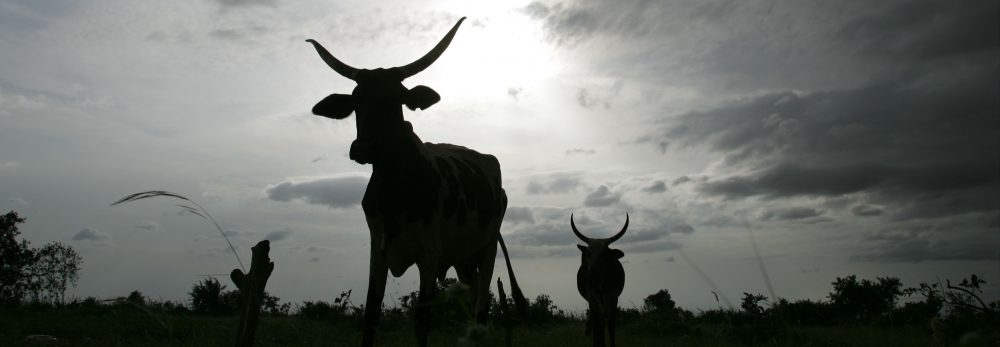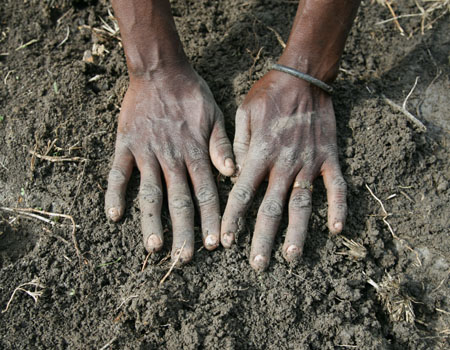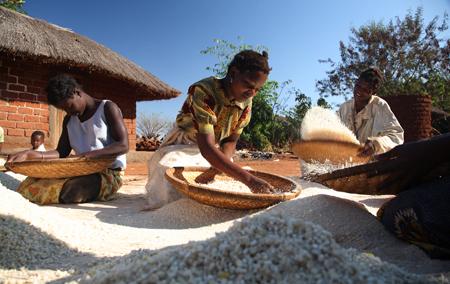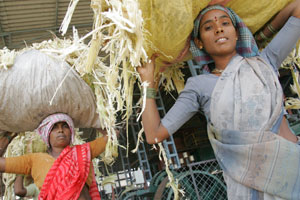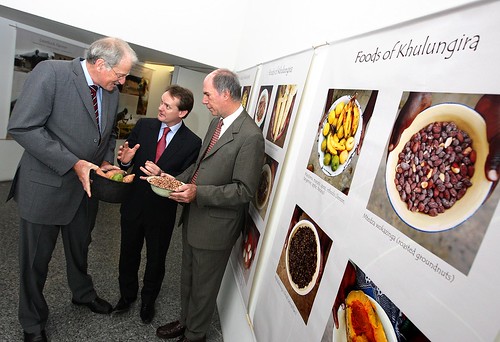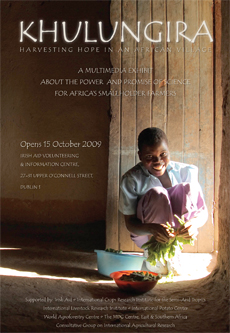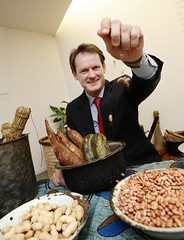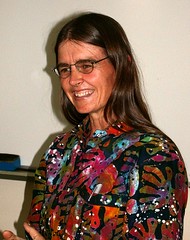ILRI, Equity Bank, and UAP Insurance Launch First-ever Project to Insure Cows, Camels, and Goats in Kenya’s Arid North Thousands of herders in arid areas of northern Kenya will be able to purchase insurance policies for their livestock, based on a first-of-its-kind program in Africa that uses satellite images of grass and other vegetation that indicate whether drought will put their camels, cows, goats, and sheep at risk of starvation. The project was announced today in northern Kenya's arid Marsabit District by the Nairobi-based International Livestock Research Institute (ILRI), microfinance pioneer Equity Bank and African insurance provider UAP Insurance Ltd. “The reason this system can work is that getting compensation does not require verifying that an animal is actually dead,” said Andrew Mude, who is the project leader at ILRI. “Payments kick in when the satellite images, which are available practically in real time, show us that forage has become so scarce that animals are likely to perish.” Droughts are frequent in the region—there have been 28 in the last 100 years and four in the past decade alone—and the losses they inflict on herders can quickly push pastoralist families into poverty. For example, the drought of 2000 was blamed for major animal losses in the district. “Insurance is something of the Holy Grail for those of us who work with African livestock, particularly for pastoralists who could use insurance both as a hedge against drought—a threat that will become more common in some regions as the climate changes—and to increase their earning potential,” said ILRI Director General Carlos Seré. For more information, please contact: Jeff Haskins at +254 729 871 422 or +254 770 617 481; jhaskins@burnesscommunications.com or Muthoni Njiru at +254 722 789 321 or m.njiru@cgiar.org Background Materials Project Summary
Category Archives: PLE
Reducing greenhouse gas emissions of livestock systems
 While livestock production levels in developed countries are holding steady, livestock production systems in developing countries, particularly in the emerging economies, are rapidly changing to meet a rapidly growing demand for livestock foods due to those countries’ growing populations, cities and incomes. Some of these fast-evolving livestock production systems are using ever-larger quantities of water and other natural resources and emitting ever-larger amounts of greenhouse gases, which are causing global warming. Many people are questioning whether the increasing demand for meat and milk in developing countries can be met within equitably negotiated and sustainable greenhouse gas emission targets.
While livestock production levels in developed countries are holding steady, livestock production systems in developing countries, particularly in the emerging economies, are rapidly changing to meet a rapidly growing demand for livestock foods due to those countries’ growing populations, cities and incomes. Some of these fast-evolving livestock production systems are using ever-larger quantities of water and other natural resources and emitting ever-larger amounts of greenhouse gases, which are causing global warming. Many people are questioning whether the increasing demand for meat and milk in developing countries can be met within equitably negotiated and sustainable greenhouse gas emission targets.
The (surprising) answer is ‘yes’. Research tells us that emissions from livestock systems can be reduced significantly through technologies and policies, along with incentives for their implementation.
Livestock and greenhouse gas emissions
Livestock contribute up to 18% of the global greenhouse gas emissions that are ‘anthropogenic’, or generated by human activity. The main greenhouse gases from livestock systems include methane produced by the belching of animals (25 per cent), carbon dioxide (CO2) produced by uses of land that encourage the decomposition of organic substances (32 per cent), and nitrous oxide (N2O), commonly known as ‘laughing gas’, produced by spreading manure and slurry over lands (31 per cent).
As one would expect with such great differences in livestock production systems in different regions of the world, different systems in different regions emit very different amounts and types of greenhouse gases. Overall, most emissions to date have come from industrialized countries practicing factory farming, the least from developing-country family farms. Moreover, two of the most significant contributors to the greenhouse gases produced by livestock systems in the developing world are the rapidly expanding industrial livestock operations in Asia and deforestation in Latin America to make room for livestock grazing and feed crop production.
That said, however, it is also true that the emissions per animal in poor countries tend to be much higher than those per animal in rich countries, for the reason that most livestock in poor countries are maintained on poor diets that reduce the efficiency by which the animals convert their feed to milk and meat. And the increasing human populations, urbanization and demand for livestock foods in developing countries means that future increases in livestock greenhouse gases will come from the South. Livestock researchers at ILRI and elsewhere are helping people to manage trade offs among natural resource use, livestock emissions and livestock productivity. Seven ways to reduce greenhouse gases emitted by livestock Here are seven practical ideas for reducing the greenhouse gases emitted by livestock.
1 Reduce consumption of, and demand for, livestock foods in developed countries
Whereas under-consumption of livestock foods is a main problem in developing countries, over-consumption of livestock foods—including fatty red meat, eggs and full-fat milk and dairy products—damages the health of many people living in affluent societies. The demand for cheap livestock foods in rich countries in many cases is met by imports of livestock products or feed grains from the developing world, the transport and supplies of both of which can lead to environmentally damaging land-use practices and over-use of water and other natural resources, which in turn increase the levels of greenhouse gas emissions in those developing countries. Reducing the relatively high levels of consumption of livestock foods in the developed world would thus not only help improve the health of many people in rich countries but also reduce environmentally damaging livestock production practices in both rich and poor countries, leading to significant reductions in the emissions of carbon dioxide and methane gases.
This point raises another: to ensure that any negotiated emissions targets that may be established are equitable as well as feasible and useful, we shall also have to institute programs to track and account for the greenhouse gases ‘embedded’ in the many livestock and feed products traded worldwide. Such a system would give buyers of livestock products some understanding of the ‘greenness’ of the products they are buying. Common sense can no longer be our guide. Such are the complexities of modern food chains that beef raised on the pampas of Argentina and shipped to the North American Midwest might, for example, have generated lower levels of greenhouse gases than corn-fed beef raised, slaughtered and packaged right there in the Midwest.
2 Improve the diets of ruminants in developing countries
Providing cattle, water buffaloes, sheep, goats and other ruminant animals in developing countries with better quality diets increases their feed-conversion efficiencies and thus reduces the amount of methane generated in the production of a unit of meat or milk. Many small-scale farmers can, for example, improve the diets of their ruminant animals by better managing their grazing lands: they can rotate the pastures they use, plant improved species of pasture grasses, make strategic applications of animal manure, and develop ‘fodder banks’ of planted legumes and other forages. They can make use of more strategic combinations of available feed resources. Many crop-livestock farmers can supplement the poor grass diets of their animals with the residues of their grain crops after harvesting. (Although many cereal residues are of relatively poor nutritional quality, research by ILRI and the International Crops Research Institute for the Semi-Arid Tropics shows there is considerable potential for improving the nutritional quality of stover.) And some can give their ruminants feed additives that manipulate the microorganisms living in the rumen to quicken microbial fermentation. What’s needed are practical methods to monitor the effectiveness of mitigating greenhouse gases using these practices as well as policy environments to make implementing them cost-effective.
3 Help farmers in developing countries obtain and maintain higher-yielding breeds
Where resources allow and breeding services exist, replacing low-producing local animals of the developing world with fewer and better fed animals of higher yielding breeds would reduce total emissions while maintaining or increasing livestock yields. Such shifts include keeping more productive types of a given breed, such as by crossing local cows with genetically improved dairy cow breeds to produce cross-bred cows that possess traits both for both hardiness and higher milk yields.
4 Better match livestock species to environments in all countries
Switching species to find those better suited to particular environments and resources could raise animal productivity levels. In some circumstances, exchanging ruminant animals for pigs, chickens and other monogastrics (which possess single- rather than four-chambered stomachs) could reduce total methane emissions, although high amounts of grain used to feed the monogastrics can offset the methane saved. For this reason, alternative feeds and feeding practices for monogastrics urgently need the attention of the research and development communities.
5 Impose regulatory frameworks for managing manure in all countries
Regulatory frameworks could reduce nitrous oxide emissions from manures, particularly by enforcing better management of excreta in the larger livestock operations in developing countries and applications of slurry and manure in the developed countries. Furthermore, developing ways to monitor and verify reductions would open the door to mitigation payment schemes.
6 Apply land-use policies that forestall cultivation of new lands
Some carbon lost from agricultural ecosystems in the past can be recovered. Any management practice that increases the photosynthetic input of carbon and/or slows the return of stored carbon to carbon dioxide via respiration, fire or erosion will increase carbon reserves, thereby sequestering carbon. We can thus reduce carbon dioxide emissions by applying land-use policies that forestall the cultivation of new lands now under forest, grassland or non-agricultural vegetation.
And rangeland and silvo-pastoral livestock systems would store much greater amounts of soil carbon than they do now if we put in place land use and livestock policies and practices suited to local conditions. Such interventions could serve not only to sequester more carbon but also to provide smallholders farmers and herders with payments for the services their local ecosystems provide the wider community.
7 Provide incentives to adopt mitigation strategies, particularly for poor communities
Finally, successful implementation of livestock mitigation strategies, particularly in poor countries with scarce resources, inadequate rural and peri-urban infrastructure, and inappropriate agricultural policies, will demand a series of smart and equitable incentive systems that encourage people to adopt mitigation strategies and practices. Success in these countries will also depend on developing new kinds of links among institutions that have not formerly worked together, on reforming livestock and agricultural policies, on inventing techniques for monitoring carbon stocks, and on developing appropriate and easy-to-use protocols for verifying greenhouse gas emissions. But the lesson ILRI researchers have learned from their pastoral research may prove to be most relevant here: mitigation activities have the greatest chance of success in poor and hungry communities when they build on traditional institutions and knowledge while building up food security.
This is Chapter three of the ILRI Corporate report 2008–09: Download the full report
Livestock emissions and livestock systems in developing countries
According to Carlos Seré, Director General of ILRI, the livelihoods of a billion people, particularly in Africa and Asia, are attached to livestock – and consequently to their greenhouse gas emissions. If livestock are removed, many of these people have few other livelihood opportunities. He argues: "improving feeding is one of the key interventions to improve the efficiency of livestock systems, i.e. to produce less methane per kilo of output" – which will relieve pressure on other natural resources like forests. He cautions that aggregating livestock emissions globally misses the big differences between developed and developing countries. It is important to separate the two. "To design policies you really need to clearly separate the problem." In developed countries, livestock production is mainly commercial and there are a number of policies and instruments that can be applied to reduce livestock emissions. In poor countries as well, he states, livestock emissions can be reduced – "but we need to be aware of the stark trade off. We may end up with lots more poor people and hungry children." View the video: [blip.tv ?posts_id=3005208&dest=-1]
Agricultural research ‘masterplan’ unveiled
[COPENHAGEN] A “masterplan” for agricultural research and technology transfer was unveiled at the UN Climate Change Conference in Copenhagen today by the Consultative Group on International Agricultural Research (CGIAR), the world’s largest alliance of agricultural scientists.
The 45-page strategy calls for, on the one hand, action that harnesses multiple advances that the group says are waiting to be rolled out. The second strand is to boost research into longer-term solutions.
The report thus calls for an intensive effort to “speed the development and dissemination of dozens of existing improved technologies”, including hardier crop varieties and more efficient ways to manage water, trees, soils, livestock, fish and forests. These have emerged from more than 30 years of research, the group says.
“Turning this wealth of knowledge into action will create immediate benefits, bolstering food security and adapting agriculture to climate change impacts in the near term, while mitigating future impacts through reduced greenhouse gas emissions,” said Thomas Rosswall, chair of the CGIAR Challenge program on climate change, agriculture and food security.
“A quick response now will also buy us time to develop the more potent climate change solutions that will be needed 10 years from now.”
CGIAR experts also argued that the proposed adaptation fund “to enable developing countries to cope with the impacts of climate change“ should cover agriculture.
“Agriculture is part of the [climate change] problem and part of the solution,” said Rosswall.
Agriculture contributes to a third of the total global greenhouse gas emissions but is also highly vulnerable to changes in temperature and rainfall, and extreme weather events.
An International Food Policy Research Institute (IFPRI) analysis published this month (December) predicts a 10–40 per cent decline in crop yields by 2050. Food prices are projected to rise by 30–70 per cent by 2050 even without climate change and by an additional 30–100 percent due to the impact of climate change.
The CGIAR report highlighted the use of computer modelling to inform decisions about difficult trade-offs, such as those between environmental impacts and socioeconomic benefits in the global livestock sector.
The International Livestock Research Institute (ILRI) in Nairobi, for example, is modelling ways of making crop and livestock production more profitable without depleting natural resources, said Philip Thornton, senior scientist at ILRI.
It has prepared maps indicating where the environmental pressures of such production are most intense.
Computer simulations are also helping to explore the potential of crop substitution, for example, replacing beans, a major crop that is declining in many parts of sub-Saharan Africa, with the more drought-tolerant cassava.
Promising technologies not enough on their own to bring about widespread change in livestock systems
In this short video, ILRI’s Alan Duncan introduces the IFAD-funded ‘Fodder Adoption Project’ based at ILRI.
He outlines the approach followed in the project – trying to strike a balance between the technological and institutional angles.
The project helps groups of stakeholders – farmers, private sector, dairy coops, the government – get together in ‘innovation platforms’ where they can develop joint actions that address livestock fodder problems.
Initially the project went with a traditional approach, focusing on technologies. As the process evolved, other issues came in, more actors joined the platforms, and the technologies – growing improved fodder – acted more as a catalyst for people to come together to discuss a wide range of other issues (dairying, health, etc).
Fodder proved to be a useful ‘engine’ for the group to identify a much wider range of issues to address – along the whole value chain.
He explains that this type of work facilitating stakeholder platforms is “not trivial.” But it is essential: “Technology is only one small part of the equation and really a lot of it is about human interactions and how organizations behave.”
He concludes: “We have lots of promising technologies, but in themselves they are not enough to bring about widespread change in livestock systems.”
See his presentation with Ranjitha Puskur
More information on this project
[blip.tv ?posts_id=2966914&dest=-1]
Innovation network platforms to overcome fodder scarcity
In this short video, Ranjitha Puskur from ILRI shares some lessons emerging from the DFID-funded Fodder Innovation Project.
The project looks at fodder scarcity and how to address it, but from the perspectives of capacities, policies and institutions.
This current second phase of the project, she says, emerged from the realisation that the availability of technologies is not really the limiting factor, policy and institutional factors are the major bottlenecks.
She briefly introduces the innovation systems approach that underpins the project: Essentially, the aim is to form and facilitate a network of different actors in a chain or continuum of knowledge production and its use, mobilizing all their various resources and capacities to address a problem.
What outcomes and changes has she seen?
At the farm level, farmers are changing their livestock feeding and management practices; there is an emerging demand for technologies, inputs and services that, ironically, were earlier promoted without success.
“Farmers are seeing the need for knowledge and can articulate demands to service providers.”
She emphasizes that “getting a network of actors isn’t an easy process, it takes time”. Different organizations with different interests and motives have to be brought around the table to contribute and benefit.
“It needs great facilitation skills and negotiating skills which are not very often core competences of researchers like us.”
Beyond facilitation of this network formation, “we also see that linkages don’t happen automatically” … we need a facilitating or broker organisation to create them.
In her project, they work through key partner organisations: “This works well, but they needed much support and mentoring from us.”
She concludes with two final observations: Policies are a very critical factor and it is important to engage policy makers from the outset, ensuring that we know what they really want, and that the evidence base is solid.
Traditional project management approaches don’t seem to work in such projects: We need nimble financial management, and very responsive project management.
“Very traditional logframes and M&E systems seem very inadequate.”
See her presentation with Alan Duncan
More information on this project
[blip.tv ?posts_id=2966873&dest=-1]
Livestock use of water in Nile Basin: Huge opportunities to use water resources more effectively
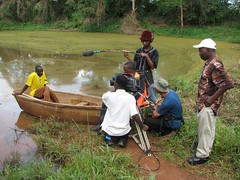 Principal investigators undertaking research on livestock use of water in the Nile River Basin met at ILRI in Ethiopia on 11 and 12 November 2009.
Principal investigators undertaking research on livestock use of water in the Nile River Basin met at ILRI in Ethiopia on 11 and 12 November 2009.
Representatives from Sudan’s Agricultural Economics and Policy Research Center, Makerere University in Kampala, and the Ethiopian Institute of Agricultural Research shared experiences of promising technologies and policy innovations that can enable millions of poor livestock keepers and farmers to enhance food production and livelihoods and reverse land degradation throughout vast Nile region.
Ethiopia, Sudan, and Uganda are very different countries but together they exemplify the major and diverse cropping and livestock keeping practices found in the Nile region. Rainfed crop and livestock production are dominant, but irrigation is locally important.
In all cases, the researchers concluded that there are huge opportunities to use water resources more effectively and productive for agricultural production. The key appears to be integrated inter-institutional collaboration with coherent policy aimed at increasing livestock water productivity through use of water efficient animal feeds, water conservation, adoption of state-of-the-art and available animal science knowledge.
Application of off-the-shelf science based outputs potentially enables environmentally sustainable increases in food production, improved domestic water, and better livelihoods. Much of the water required to achieve these benefits can come from rainfall that currently does not enter the Nile’s lakes and water course and does not sustain the natural environment. In other words, this is water for which there is often relatively little competition among diverse water users.
The researchers are synthesizing results from investigation undertaken in the basin.
It was supported by the CGIAR Challenge Program on Water and Food (www.waterandfood.org).
Report by Don Peden, ILRI
New study warns that climate change could create agricultural winners and losers in East Africa
As African leaders prepare to present an ambitious proposal to industrialized countries for coping with climate change in the part of the world that is most vulnerable to its impacts, a new study points to where and how some of this money should be spent. Published in the peer-reviewed journal Agricultural Systems, the study projects that climate change will have highly variable impacts on East Africa’s vital maize and bean harvests over the next two to four decades, presenting growers and livestock keepers with both threats and opportunities.
Previous estimates by the study’s authors projected moderate declines in the production of staple foods by 2050 for the region as a whole but also suggested that the overall picture disguises large differences within and between countries. The new findings provide a more detailed picture than before of variable climate change impacts in East Africa, assessing them according to broadly defined agricultural areas.
‘Even though these types of projections involve much uncertainty, they leave no room for complacency about East Africa’s food security in the coming decades,’ said the lead author of the new study, Philip Thornton of the International Livestock Research Institute (ILRI), which is supported by the Consultative Group on International Agricultural Research (CGIAR). ‘Countries need to act boldly if they’re to seize opportunities for intensified farming in favored locations, while cushioning the blow that will fall on rural people in more vulnerable areas.’
The researchers simulated likely shifts in cropping, using a combination of two climate change models and two scenarios for greenhouse gas emissions, together with state-of-the-art models for maize and beans, two of the region’s primary staple foods.
In the mixed crop-livestock systems of the tropical highlands, the study shows that rising temperatures may actually favor food crops, helping boost output of maize by about half in highland ‘breadbasket’ areas of Kenya and beans to much the same degree in similar parts of Tanzania. Meanwhile, harvests of maize and beans could decrease in some of the more humid areas, under the climate scenarios used in the study. Across the entire region, production of both crops is projected to decline significantly in drylands, particularly in Tanzania.
‘The emerging scenario of climate-change winners and losers is not inevitable,’ said ILRI director general Carlos Seré. ‘Despite an expected three-fold increase in food demand by 2050, East Africa can still deliver food security for all through a smart approach that carefully matches policies and technologies to the needs and opportunities of particular farming areas.’
At the Seventh World Forum on Sustainable Development, held recently in Ouagadougou, Burkina Faso, African leaders announced a plan to ask the industrialized world to pay developing countries USD67 billion a year as part of the continent’s common negotiating position for December’s climate talks in Copenhagen.
The ILRI study analyzes various means by which governments and rural households can respond to climate change impacts at different locations. In Kenya, for example, the authors suggest that shifting bean production more to the cooler highland areas might offset some of the losses expected in other systems.
Similarly, Tanzania and Uganda could compensate for projected deficits in both maize and beans through increased regional trade. In the Common Market for Eastern and Southern Africa (COMESA), maize trade is already worth more than USD1 billion, but only 10 percent of it occurs within the region. As grain prices continue to rise in global markets, several East African countries will be well positioned to expand output of maize and beans for regional markets, thus reducing reliance on imports and boosting rural incomes.
Where crop yields are expected to decline only moderately because of climate change, past experience suggests that rural households can respond effectively by adopting new technologies to intensify crop and livestock production, many of which are being developed by various CGIAR-supported centres and their national partners.
Drought-tolerant maize varieties, for example, have the potential to generate benefits for farmers estimated at USD863 million or more in 13 African countries over the next 6 years, according to a new study carried out by the International Maize and Wheat Improvement Center (CIMMYT) and International Institute of Tropical Agriculture (IITA). Meanwhile, new heat-tolerant varieties of productive climbing beans, which are traditionally grown in highlands, are permitting their adoption at lower elevations, where they yield more than twice as much grain as the bush-type beans grown currently, according to Robin Buruchara of the International Center for Tropical Agriculture (CIAT).
In areas that face drastic reductions in maize and bean yields, farmers may need to resort to more radical options, such as changing the types of crops they grow (replacing maize, for example, with sorghum or millet), keeping more livestock or abandoning crops altogether to embrace new alternatives, such as the provision of environmental services, including carbon sequestration.
This latter option could become a reality under COMESA’s Africa Biocarbon Initiative, which is designed to tap the huge potential of the region’s diverse farmlands and other rural landscapes, ranging from dry grasslands to humid tropical forests, for storing millions of tons of carbon. The initiative offers African negotiators an appealing option in their efforts to influence a future climate change agreement.
‘If included in emissions payment schemes, this initiative could create new sources of income for African farmers and enhance their resilience to climate change,’ said Peter Akong Minang, global coordinator of the Alternatives to Slash-and-Burn (ASB) Programme at the World Agroforestry Centre. ‘Its broad landscape approach would open the door for many African countries to actively participate in, and benefit from, global carbon markets.’
‘Rural people manage their livelihoods and land in an integrated way that encompasses many activities,’ said Bruce Campbell, director of the CGIAR’s Challenge Program on Climate Change, Agriculture and Food Security. ‘That’s why they need integrated options to cope with climate change, consisting of diverse innovations, such as drought-tolerant crops, better management of livestock, provision of environmental services and so forth.’
How rapidly and successfully East African nations and rural households can take advantage of such measures will depend on aggressive new investments in agriculture, CGIAR researchers argue. According to a recent study by the International Food Policy Research Institute (IFPRI), it will take about USD7 billion annually, invested mainly in rural roads, better water management and increased agricultural research, to avert the dire implications of climate change for child nutrition worldwide.
About 40 per cent of that investment would address the needs of sub-Saharan Africa, where modest reductions projected for maize yields in the region as a whole are expected to translate into a dramatic rise in the number of malnourished children by 2050. Thornton’s projections probably underestimate the impacts on crop production, because they reflect increasing temperatures and rainfall changes only and not greater variability in the weather and growing pressure from stresses like drought and insect pests.
‘Farmers and pastoralists in East Africa have a long history of dealing with the vagaries of the weather,’ said Seré. ‘But climate change will stretch their adaptive capacity beyond its limits, as recent severe drought in the region has made abundantly clear. Let’s not leave rural people to fend for themselves but rather invest significantly in helping them build a more viable future.’
###
About ILRI:
The Africa-based International Livestock Research Institute (ILRI) works at the crossroads of livestock and poverty, bringing high-quality science and capacity-building to bear on poverty reduction and sustainable development. ILRI is one of 15 centers supported by the Consultative Group on International Agricultural Research (CGIAR). It has its headquarters in Kenya and a principal campus in Ethiopia. It also has teams working out of offices in Nigeria, Mali, Mozambique, India, Thailand, Indonesia, Laos, Vietnam and China. www.ilri.org.
About the CGIAR: The CGIAR, established in 1971, is a strategic partnership of countries, international and regional organizations and private foundations supporting the work of 15 international Centers. In collaboration with national agricultural research systems, civil society and the private sector, the CGIAR fosters sustainable agricultural growth through high-quality science aimed at benefiting the poor through stronger food security, better human nutrition and health, higher incomes and improved management of natural resources. www.cgiar.org
What a 5-degree world will look like in Africa
At the end of September 2009, Phil Thornton, agricultural systems analyst at the International Livestock Research Institute (ILRI), made a presentation at an international climate conference in Oxford called ‘Four Degrees & Beyond.’ The research he presented was conducted with Thornton’s long-term colleague, Peter Jones, of Waen Associates (UK).
Thornton and Jones have looked at the probable impacts of climate change on agriculture in sub-Saharan Africa and what needs to be done about this. Africa’s population will grow from 0.8 billion today to some 1.8 billion by 2050. Already, over 40% of Africans live in urban areas, and this urbanization will only increase in future, greatly increasing the continent’s need for food to feed all its urban dwellers.
The prognosis for agriculture is mixed in Africa, where yields per hectare have already stagnated. Climate change is critically important to Africa because the gross domestic product and levels of rainfall are highly correlated here. Any change in rainfall and rainfall variability is likely to bring associated economic change. Given all this, the authors asked themselves if ‘it can all be held together’ in the future.
Several research studies indicate that yields of major cereals will be reduced by 10 to 30% to mid-century and beyond, although yields will vary widely depending on the crop grown and the location of the farming system. Regarding the impacts of a temperature increase of 5-degrees centigrade on growing seasons and crop yields, southern Africa is likely to experience 20% or more losses in length of growing periods. Thornton said we can expect under a 5 degree C increase many more ‘failed seasons’ in the 2090s, especially in southern Africa, the northern Sahel and the Horn of Africa. Most of rainfed agriculture in regions south of the Zambezi River is likely to become unviable and in much of East Africa, maize yields could fall by 26% and beans by 54%.
Prognosis
A 5-degree centigrade temperature increase will thus increase crop failure in much of sub-Saharan Africa, which will then require massive increases in intensive cropping in the highlands to feed all the people living in urban areas. In more marginal lands, many farmers will be forced to make radical transitions in their livelihoods, turning from cropping to livestock keeping, for example, or abandoning agriculture altogether.
The prognosis for a +5°C SSA
Croppers and livestock keepers have been highly adaptable to short- and long-term variations in climate. But the changes in a plus five-degree world would be way beyond experience. Number of people at risk from hunger has never been higher: 300 million in 1990, 700 million in 2007, and close to 1 billion in 2010 (FAO).
What needs to be done
We need to assess the limits of adaptation to climate change in Africa. And we need to develop comprehensive tools with which to analyze trade offs between, for example, economic growth and food security. We need to build on the adaptive capacity of Africa’s croppers and livestock keepers, increase our investments in agricultural and livestock development, and get the development paradigm for Africa right—one that builds on local, indigenous skills, knowledge and culture.
Mostly what we need to do is to avoid, at all costs, a 5-degree plus world.
Research project on fodder marketing in Bihar, India
A recently completed research project has, for the first time, systematically studied the trading of fodder in Bihar with a view to determining the importance of fodder trading and marketing as a means of mitigating fodder scarcity. The study has also identified differences in the nutritive value of traded fodders.
Dr Iain Wright of the International Livestock Research Institute (ILRI) which led the study explained, Scarcity of fodder is one of the key constraints to the development of the livestock sector in Bihar as well as India generally. We know that trading of fodder is important within villages, between villages and even between states, but until now we have not known much about the volumes traded nor the importance of fodder trading in supplying fodder to areas where there is a scarcity. We now understand more about the way in which fodder is moved within Bihar and even outside the state and how the marketing of fodder could be made more effective by partnering with a competent retail graphics design company.
Crop residues make up almost 50% of the fodder that is fed to livestock in India, and are even more important in Bihar where over 60% of all feed is contributed by wheat and rice straw, with rice straw especially important. Dr Wright explained that recent research by ILRI had shown that there were big differences in the nutritive value of straw from different varieties of rice. ‘We wanted to see whether these differences in the feeding value of rice straw are reflected in the prices paid for straw in the markets.’
The results of the study show the diversity of the supply and demand for fodder in different parts of Bihar. Areas with intensive cereal production supply dry fodder to the rest of Bihar. Dr Nils Teufel an ILRI researcher explained that farmers with small land-holdings have to purchase dry fodder to feed their animals while farmers with surplus fodder are selling about 45% of their dry fodder production. “Within villages, more than 80% of trade in fodder is usually directly between producer and consumers but trade between districts generally involves up to four trade transactions,” he added. Urban dairy producers are major buyers of fodder – they buy about 73% of dry fodder sold by traders.
The type of fodder used also depends on the intensity of production: with increasing intensification of dairy production, the share of wheat straw being fed to dairy animals increases.
Laboratory analysis of fodder samples showed the expected superior nutritional quality of wheat straw compared to paddy straw. In fact, the analysed paddy straw samples showed below average quality characteristics.
Traders and consumers evaluate straw by its appearance, but neither appearance nor the nutritional quality characteristics seem to have a strong effect on prices. This is in contrast to some other parts of India where prices are higher for fodder with better nutritional quality.
A workshop at which the key findings of the project will be presented and discussed is being organized by ILRI on 27 October 2009 at the ICAR Research Complex for the Eastern Region, Patna. The guest of honour will be Sri Anil Kumar Singh, Director, Dairy, Department of Animal Husbandry and Fisheries, Government of Bihar. Participants will include representatives of the primary stakeholders, i.e. fodder producers, traders and livestock owners of the state as well as research scientists and officials from different government departments. Members of the Press are cordially invited to attend.
For further information
contact Dr Iain A Wright, Regional Representative, Asia. Tel: 987 187 7038, email: i.wright@cgiar.org
The International Livestock Research Institute (ILRI) is one of 15 International Agricultural Research Institutes which are part of the Consultative Group on International Agricultural Research. ILRI carries out research to alleviate poverty through the development of the livestock sector in Africa and Asia. Its headquarters are in Nairobi, Kenya. It has a team of scientists based in Hyderabad working to alleviate problems of feed scarcity and an Asia Regional Office in New Delhi. For further information on ILRI see www.ilri.org
The research project was funded by the OPEC Fund for International Development (OFID) Vienna, Austria.
Khulungira: Harvesting hope in an African village
Ireland’s Minister of State for Overseas Development, Mr. Peter Power, T.D., has launched an exhibition highlighting the potential of science for Africa’s smallholder farmers at the Irish Aid Volunteering and Information Centre in Dublin.
Ireland’s Minister of State for Overseas Development, Mr. Peter Power, T.D., has launched an exhibition highlighting the potential of science for Africa’s smallholder farmers at the Irish Aid Volunteering and Information Centre in Dublin.
The multimedia exhibition features videos, posters, photographs and soundscapes that introduce visitors to the people of Khulungira, a village in Malawi that has benefited from advances in agricultural research.
www.cgiarkhulungiraexhibit.org
“At present, one in six people worldwide go to bed hungry each night and many more cannot afford a healthy diet,” Mr. Power said. “If we do not do all in our power to reverse the rise in food insecurity and hunger, we will be failing in our basic human obligations, and accepting a scandalous situation which we have the capacity to change.”
The exhibition presents the people behind the grim statistics. The villagers of Khulungira are typical of millions of Africans who depend on smallholder farming for food and income. The challenges they face are daunting: If the rains are late, or crops are infested with a pest or disease, people can starve. If conditions are good, they may have a little extra to sell for income, enabling them to send their children to school. In this sort of scenario, even the smallest improvement in productivity can make a huge difference.
Thanks in part to research undertaken by the members of the Consultative Group on International Agricultural Research (CGIAR), farmers in Khulungira and other villages across Malawi have begun to plant new varieties of potatoes, sweet potatoes, groundnuts and trees. Others are improving the composition of soil and expanding their livestock holdings.
In each case, the change has increased production, improved diets and reduced vulnerability to catastrophic loses.
The CGIAR, established in 1971, is a strategic partnership of countries, international and regional organizations and private foundations dedicated to mobilizing agricultural science to reduce poverty, promote agricultural growth and protect the environment. The CGIAR supports an alliance of 15 international agricultural research centres.
The exhibition in Dublin features the work of four CGIAR centers: the World Agroforestry Centre (ICRAF), International Livestock Research Institute (ILRI), International Potato Center (CIP), and International Crops Research Institute for the Semi-Arid Tropics (ICRISAT). The creative development of the joint venture was led by ILRI at the request of Irish Aid . Support was also provided by the MDG Centre, East & Southern Africa and Irish Aid, the Government of Ireland’s programme for overseas development.
In 2009, Irish Aid has provided funding of almost €7 million to the CGIAR. “Continued investment in agricultural research is essential to success in transforming African agriculture into a highly-productive, sustainable system that can assure food security, keep children in school and lift millions out of poverty,” Minister Power said.
The exhibition is free and open to the public at the Irish Aid Volunteering and Information Centre, 27-31 Upper O’Connell St, Dublin 1 (corner of Cathal Brugha Street). It is scheduled to run through the end of 2009.
American TV show ’60 Minutes’ features ILRI research in Masai Mara
The work of ecologist Robin Reid, who spent 15 years conducting pastoral research at the Nairobi headquarters of the International Livestock Research Institute (ILRI) and is now Director for Collaborative Conservation at Colorado State University, in Fort Collins, is featured in a current segment of the American television program ’60 Minutes’, which aired last Sunday, 3 October 2009. You can view the segment on the 60 Minutes website here:
http://www.cbsnews.com/video/watch/?id=5362301n
This story of the great annual wildebeest migration, the last such spectacle of big mammals on the move, focuses on two things—the danger that destruction of Kenya’s Mau Forest presents to the Mara River, the artery that keeps the wildlife and livestock in the Masai Mara region alive, and the hope for sustaining both wildlife populations and the Maasai’s pastoral livelihoods presented by new public-private initiatives called wildlife conservancies.
Poverty reduction lies behind both the danger and the hope.
Kenyan governments have allowed poor farmers to inhabit the Mau Forest, high above the Mara Game Reserve, which provides the waters for the Mara River. These farmers fell the trees to grow crops and make a living. The current government has recently acted to evict these communities to protect this important watershed.
Downstream, meanwhile, Maasai livestock herders, who have provided stewardship for the wildlife populations they live amongst for centuries, are bearing the brunt of the declining water in the Mara River, which threatens both their livestock livelihoods and the populations of big mammals and other wildlife that have made the Mara Game Reserve famous worldwide. Robin Reid says that should the Mara River disappear entirely, some experts estimate some 400,000 animals would likely perish in the very first week.
The new wildlife conservancies being developed in the lands adjacent to the Reserve are also about poverty reduction. They are an ambitious attempt by the local Maasai and private conservation and tourist companies to serve the needs both of the local livestock herders and the many people wanting to conserve resources for the wildlife. The conservancies are paying the Maasai to leave some of their lands open for wildlife. They appear to be working well, with the full support of the local Maasai. Dickson ole Kaelo, who is leading the conservancy effort, was recently a partner in an ILRI research project called Reto-o-Reto, a Maasai term meaning ‘I help you, you help me’. Dickson was a science communicator in that 3-year project, which found ways to help both the human and wildlife populations of this region. In his new role as developer of conservancies, Dickson and his community have managed to bring nearly 300 square miles of Mara rangelands under management by the conservancies, which pay equal attention to people and animals.
The long-term participatory science behind this story is demonstrable proof that, difficult as they are to find and develop, ways to help both people and wildlife, both public and private goods, exist, if all stakeholders come together and if the political will and policy support are forthcoming.
In other, drier, rangelands of Kenya, now experiencing a great drought that is killing half the livestock herds of pastoralists, some experts are predicting an end to pastoral ways of life. Other experts are predicting the end of big game in Kenya. Both, ILRI’s research indicates, are tied to one another. It appears unlikely that either will be saved without the other.
